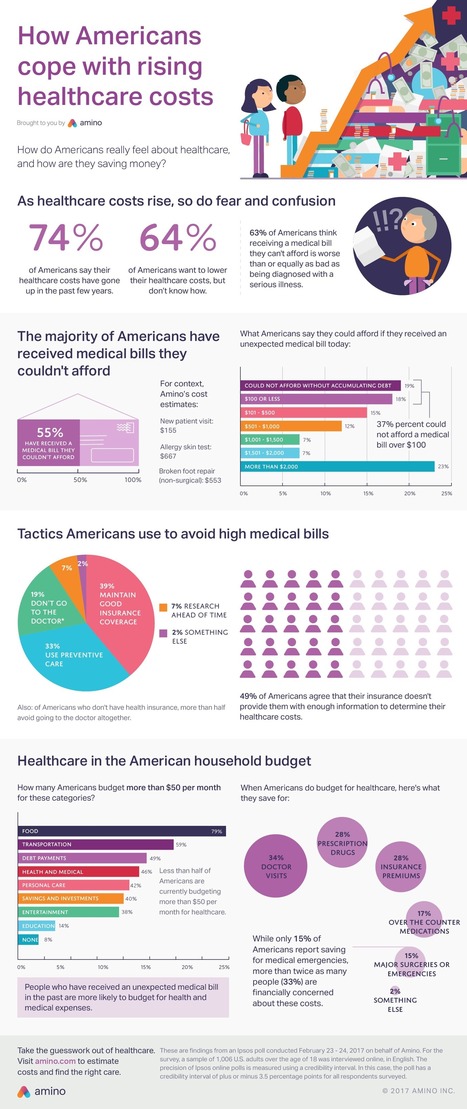For what feels like a long time now, I have been talking with photographers about the value clients are placing on video. I have been encouraging photographers to find a solution for motion that works for them, whether it be a DP or they themselves holding the camera. Either way, the writing has been on…
Get Started for FREE
Sign up with Facebook Sign up with X
I don't have a Facebook or a X account

 Your new post is loading... Your new post is loading...
 Your new post is loading... Your new post is loading...
We believe these are those issues - the macro-trends that will directly affect pharma in 2016. Here, we describe them, we dissect them, and we break them down into what they mean to you, the pharma marketer.
Pharma enterprises have a uniquely complex set of challenges when it comes to launching products in the digital space. As their digital partner, customer
Digital factories—central, shared organizations that coordinate and deliver digital platforms and related services for the wider company—are here to stay. But are large pharmaceutical firms getting the most out of them? And how do you set the team up for success? Digital executives at global pharmaceutical firms need to calibrate six success factors to achieve the promised benefits of digital factories: a competitive time to market, reduced cost, and world-class digital capability. Via Lionel Reichardt / le Pharmageek
Join me at the 9th Digital Pharma Europe event this 17-19 May in London. Save 15% w/ my speaker code C865VIP! https://t.co/4QLI0EGorV
Less than 5% of patients with cancer participate in clinical trials, and most publicly funded cancer trials in the US fail to enroll sufficient numbers of patients to generate reliable results.1 For patients who do participate in clinical trials, they may not be representative of the population of individuals with cancer – participation is particularly low among older individuals and those in some racial and ethnic groups.2 Barriers to clinical trial participation were discussed at December’s American Society of Hematology (ASH) annual meeting. In a special-interest session on social media and clinical trials, the use of Twitter for clinical trial recruitment was discussed by a panel that included several clinicians and a patient advocate. The other session was an industry/advocacy forum on creating a diversified clinical trial and included the patient point of view. Patient Perspective on Barriers to Trial ParticipationJennifer Ahlstrom, Founder, Myeloma Crowd, Salt Lake City, Utah, presented the patient perspective at the social media session. Ms. Ahlstrom says that trying to enroll in a clinical trial is “labor intensive” for patients who don’t feel well, are scared and think they may be dying and don’t know what their options are. “That’s a hard time to make decisions,” she said. She was diagnosed in 2010 with multiple myeloma and assumed after her initial treatment she would join a clinical trial because of recurrence. She searched clinicaltrials.gov and discovered over 450 open myeloma trials. “I didn’t understand any of the drug names, what they did, what they were for, even the standard therapies.” She called 8 facilities to learn about their clinical trials and got a call back from two. “The process is not patient-centered,” she said. “You have to really fight to get into clinical trials and [it’s] a big reason patients don’t join.” Ms. Ahlstrom said another reason patients don’t join clinical trials is that their doctor doesn’t refer them, whether it’s because they don’t want them to go outside their practice or they just don’t know what clinical trials are open at other facilities. To inform other patients with myeloma about clinical trials, she started an online radio show, Myeloma Crowd Radio, which features hour-long interviews with investigators, asking them to explain their research and clinical trials, including the rationale and eligibility in patient-friendly language. To date, 95 shows have been produced and archived, and are available as audio files and transcripts to a million listeners and readers. Her Myeloma Crowd website shares news about trials, and its SparkCures tool allows patients to access information about vetted clinical trials that would be appropriate for them. Barriers for MinoritiesOn the topic of increasing clinical trial diversity, Cheryl A. Boyce, Patient Ambassador, Columbus Ohio, said, “the efficacy of a drug is really important for anyone who has an active disease process. And with many drugs I’m not sure what the efficacy is for people who are African American. So, the diversity issue is of critical importance.” She used the Tuskegee Study of Untreated Syphilis in the Negro Male — now referred to as the US Public Health Service Study3 — and the more recent experiences of Henrietta Lacks, whose tumor was the source of the widely-used HeLa cells,4 as examples of how things can go very wrong for people of color. She said that many people in African American communities have heard those stories, and find it difficult to put trust in researchers who don’t look like them, or understand the cultural context of their belief systems. The underrepresentation of people of color as clinical investigators works against clinical trial recruitment. Twitter as a Recruitment AidWith Twitter, Michael A. Thompson, MD, PhD, Aurora Health Care, Milwaukee, Wisconsin, pointed out that pharmaceutical companies can tweet links to publicly available clinical trial information, e.g., if it is on clinicaltrials.gov, and suggested including the NCT number for tracking. However, additional content not publicly available would probably require institutional review board approval to disseminate. He suggested pharmaceutical companies could use Twitter to follow conversations, e.g., those occurring at medical meetings, but not use it to promote their booths at those meetings. The FDA has developed draft guidances to present information on drugs and devices using internet and social media platforms with character space limitations, i.e., Twitter,5 as well as a guidance for correcting third-party misinformation about drugs and devices.6 In general, information distributed by pharma on social media is subject to the same regulations that apply to distribution by any other means. Joseph Mikhael, MD, Mayo Clinic Cancer Center, Phoenix, Arizona, acknowledged that many patients who may be eligible for clinical trials may not be on social media, but that often their family members or caregivers are. However, some patients will never be on Twitter, so other means of patient contact will be needed. “Recruiting underrepresented minorities in clinical trials remains a grave challenge in medicine, and the use of social media might help by broadening the scope of information about clinical trials and research in general,” he said. Dr. Thompson offered that a search of hashtags associated with ASH and the American Society of Clinical Oncology (ASCO) meetings allowed him to locate an appropriate local trial for a patient. Ultimately it seemed that social media might be more useful for providers than patients. Patient-Driven SolutionsMs. Ahlstrom said that The Myeloma Crowd has run live patient meetings that were highly technical. This year they are producing pilot meetings for the minority community that are more basic, and have the theme of 5 steps to getting the best myeloma outcome. One of those steps is to be aware of clinical trials. Ms. Ahlstrom said, “I think one key thing is that the minority communities need to understand why knowing more is in their self-interest. It truly means longer life, which we want everyone to have.” Ms. Boyce will be helping The Myeloma Crowd to identify topics that will apply to minority communities. She noted that the Intercultural Cancer Council has identified barriers to participation by underrepresented populations in clinical trials, and published policy recommendations several years ago.7 She said, “We know what we need to do; we just haven’t found the political will to do it. We’re better at planning than at implementing.” Recommendations include removing barriers like lack of transportation or insurance, having awareness and education campaigns, addressing mistrust and language barriers, recruiting minority investigators, and encouraging referrals to clinical trials. “If clinical trial participation is truly a priority in this country, we have to find a way to bring policy makers, industry, clinicians and community advocates together to figure out what parts of current policy are contradictory and serve as barriers themselves before we ever engage people. Every role should be defined and what support services are necessary to overcome barriers,” Ms. Boyce said. She envisions a national education campaign that could even include information on cereal boxes and milk cartons, so the public will learn about clinical trials and research long before they may ever need to think about their own participation. The Role of Advocacy OrganizationsDaniel Auclair, PhD, VP, Multiple Myeloma Research Foundation (MMRF), Norwalk, Connecticut, said that patient advocacy groups can help break through barriers such as distrust toward pharma companies sponsoring trials and of the clinical trial process more generally. Advocacy organizations may be able to provide better education about clinical trials to both clinicians and patients as well as devise personalized approaches to engage specific patient communities. He noted that the Multiple Myeloma Research Foundation (MMRF) (like other advocacy foundations) has a personalized clinical trial matching tool that is more patient-friendly and has more patient-specific information than that on clinicaltrials.gov, as well as a patient call center staffed 7 days a week around the clock. Dr. Auclair said they need to go to patients “on their turf, in their terms.” Patients who have been in clinical trials can serve as patient ambassadors to bring information to their community to learn more about trials. Patients need to be active participants and they need to be supported so they can participate in clinical trials because “clinical trials test new drugs and new drugs save lives,” he concluded. Looking AheadMs. Ahlstrom, Ms. Boyce, and Dr. Auclair all noted that when African Americans, who have fared poorly in the past, have improved access to treatment, they may do better than others with myeloma, probably due to lower-risk genetic abnormalities. Dr. Auclair said that myeloma has been the “poster child” for disparities, as African Americans have 2 to 3 times the rate of myeloma as other populations. If the results of small studies showing they fare as well or better with treatment were replicated in larger studies, those data could support the entire population receiving treatment. Dr. Auclair said that one reason clinical trial enrollment may be higher in other areas, e.g., Europe, is that the healthcare system tightly regulates the availability of drugs. The only way patients may have access to the newest agents is if they participate in clinical trials. “Especially in this climate, more than ever, we may want to think about the access issues and the socioeconomic issues. We don’t know where the system is going but it may become a little more like in Europe, where going onto clinical trials will be a way where you can access these drugs that you can access now, but may not be able to access in the near future. I think clinical trials may become more important in the future than they are now,” he said. Via Plus91, Giuseppe Fattori
Healthcare costs continue to climb around the globe. The advent of the internet of things has the potential to revolutionize the traditional paper-based healthcare treatment through the access of real-time patient data and remote patient monitoring. Connected healthcare, particularly for chronic sufferers, enables improved patient care and encourages patient self-management while at the same time lowering costs. Via Giuseppe Fattori
If you search the Web you’re going to find a lot of statistics on social media and health, but what you’re not going to find is how and why people are using social media for health. Th… Via Richard Meyer
As part of efforts to better capture patients' perspectives, the US Food and Drug Administration (FDA) on Monday said it is considering establishing an "Office of Patient Affairs," to be tasked with supporting and coordinating patient engagement across the agency.
The move to create the office would be part of the agency’s efforts to offer “a single, central entry point to the Agency for the patient community,” as well as “triage and navigation services for inbound inquiries from patient stakeholders.”
The office would likely host and maintain data management systems to incorporate and formalize knowledge shared with FDA by patient stakeholders and FDA's relationships with patient communities, and the office would be part of efforts to develop a scalable and forward-looking platform for communicating with patient stakeholders, particularly online.
Further Reading: “The New, Patient-Centric FDA: A Double-edged Sword”; http://sco.lt/5la6qnVia Pharma Guy, Giuseppe Fattori, Esposito Christelle, Lionel Reichardt / le Pharmageek
Health care, like many industries, places great emphasis on innovation. In just the past decade, we have moved rapidly from paper medical records to electronic ones and web portals that let information pass seamlessly between health systems and patients at the touch of a finger. Smartphone apps, wearables, medical devices, and other gadgets that promise to improve health are being developed at an ever faster pace. These developments often come from companies and startups that are relatively new to health care.
Via Giuseppe Fattori 
Aristide Adjinacou's curator insight,
March 21, 2017 6:33 AM
On a tendance à oublier que le plus important est la relation humaine et le dialogue avec les patients. La technologie n'est un support qui doit être bien utilisé. Dans ce monde aujourd'hui ou tout va très vite n'oublions pas que nous sommes encore des humains.
Gilead Sciences Inc.’s hepatitis C cure set off a firestorm of criticism over high drug prices in 2014 that hasn’t let up since. Now an executive says the company can’t cut the product’s price because middlemen who manage drug benefits would refuse to cover it. Via Richard Meyer
Spending on direct-to-consumer pharmaceutical ads rose 9% to $5.6 billion in 2016 [see note below], in part fueled by a 16% boost in spending from Bristol-Myers Squibb, according to data from Nielsen. Via Pharma Guy, Lionel Reichardt / le Pharmageek 
Pharma Guy's curator insight,
March 6, 2017 10:33 AM
Note: The 2016 data comes from Neilsen. The data in my chart for 2014 and 2015 comes from Kantar Media, which generally reports slightly higher numbers. In 2015, for example, Kantar estimated the DTC spend to be $5.4 billion whereas Neilsen estimated it to be around $5.2. Whatever the source, it is clear that DTC ad spending is at an all-time high. I included data from AARP regarding its estimate of % price increase for drugs used by older Americans.
Nurture a stronger customer relationship through informative email marketing. |
Following in the footsteps of Eli Lilly and Roche, Sanofi has quietly received FDA clearance for a smartphone app with a built-in insulin dose calculator. According to FDA documents, the app, cleared at the end of March, is called My Dose Coach.
Ahead of the marcus evans PharmaMarketing Summit 2017, Bryan Cohen discusses why pharma marketers need to view the journey through the consumer’s eyes
Digital factories—central, shared organizations that coordinate and deliver digital platforms and related services for the wider company—are here to stay. But are large pharmaceutical firms getting the most out of them? And how do you set the team up for success? Digital executives at global pharmaceutical firms need to calibrate six success factors to achieve the promised benefits of digital factories: a competitive time to market, reduced cost, and world-class digital capability. Via Lionel Reichardt / le Pharmageek, eMedToday, Olivier Delannoy
In an expert view piece.Michael Jewell.healthcare partner at Cavendish Corporate Finance.discusses why acquiring exclusive rights will continue to be a key driv
Studies testing drugs 20 years after their expiry dates found in 12 out of 14 cases that they were still usable.
From
amino
64% of Americans want to lower their healthcare costs, but don’t know how. Read more from a recent survey by Amino and research firm Ipsos. Via Richard Meyer
In the recent issue of the American Journal of Bioethics, the target article addresses the ethics of finding participants for clinical trials on social media sites. The authors, from Harvard Law School and Harvard Medical School, analyzed the particular ethical issues that occur in the online setting compared to in-person recruitment and provide practical recommendations for investigators and Institutional Review Boards (IRBs).
Via Plus91, Giuseppe Fattori
In this study, we’ve tracked the trends in the pharma industry. Take a look at best practices for social content publishers and social media marketers. Via Richard Meyer
Medtech startup AliveCor announced this morning it has pulled in $30 million from Omron Healthcare and the Mayo Clinic and is launching an artificially intelligent stroke prevention platform for doctors called KardiaPro. AliveCor already has an FDA-cleared mobile app called Kardia to accompany its $99 standalone EKG reader device. However, a partnership last year with the Mayo Clinic involving 4,500 patients for a major study on stroke prompted the company to build the new platform, which is a premium offering for doctors who want to monitor the EKG readouts of patients at potential risk for stroke or other heart-related diseases.
Via Giuseppe Fattori
A discussion of the ways in which virtual meetings can help pharma build meaningful relationships and encourage HCP engagement. Via COUCH Medcomms
Yes, it’s true that you’re a busy pharmaceutical communications exec: Why would you add another online channel to your already-loaded pharma marketing toolkit? Especially since Pinterest and Instagram are basically the same: Both are image-driven social media platforms, using visuals in marketing that encourage sharing and engage your target audience.
But that’s where the similarities end. Pinterest and Instagram have distinct purposes and applications, so a better question is: Why would you limit your reach and capabilities by choosing one over the other? Consider the primary function of each…
So, it’s curate versus capture. But when you dig a little deeper…
Now you can see how the distinction between the two is quite profound. You can also understand that different types of messages and images will resonate with users on Pinterest as compared to Instagram – because they’re active on these platforms for entirely different reasons. You can’t optimize engagement, raise brand awareness, and develop a loyal following without understanding which one to use, for what reasons, and when.
When to Use What
Linking: When you pin an image on Pinterest, it will include a link to the source of the content on an external site. If that external site is yours, you drive website traffic every time someone clicks on the pin, increase that traffic potential exponentially every time someone re-pins it, and boost SEO.
When you post an image on Instagram and share it across other social media channels, they’re directed to that content’s individual link. That person isn’t heading to your website, but to the Instagram-generated link and your profile.
Storytelling: You tell your stories on Pinterest through the stories of others, on the themed boards you create to gather your pins. It’s possible to distribute promotions and hold contests to engage your audience and invite them into your story.
Instagram users are seeking a more personalized experience when they engage with brands on the platform. Because you’re posting content that you create yourself, you can establish a more individual connection between your company and the user. Instagram content is consumable through quick captions, images, and video clips – unique content that communicates information about the products you offer.
Target Audience: Woman account for roughly 85 percent of Pinterest users, a figure that represents that largest gender differential on all social networks. When you consider that women are more likely to seek health information online as compared to men (85 and 75 percent, respectively), SEO becomes a factor – making the advantages of Pinterest clear.
Still, Instagram has more active monthly users, at 500 million compared to Pinterest’s 150 million according to 2016 figures. So if it’s breadth you seek with pharma marketing, Instagram may be your best bet.
There’s no clear winner between Pinterest and Instagram, but there is a clear point: You want to use one over the other, depending on your goal. The key is understanding the different users of each platform and why they’re hanging out there Via Plus91, Esposito Christelle, Celine Sportisse
Research and Markets has announced the addition of the "Innovative |




























